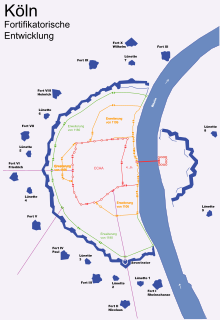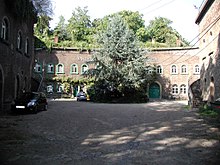Fort X of the fortress ring Cologne
The Fort X of the fortress ring Cologne is part of the Prussian Cologne fortress ring , a military fortification in Cologne Neustadt Nord close to the inside channel street , which is still preserved today.
History of origin
Fort X is one of the eleven forts originally built on the inner belt around Cologne on the left bank of the Rhine. They were intended to reinforce the city defense systems ( city wall ).
After the city was liberated by Prussian troops on January 15, 1814 and fell to Prussia at the Congress of Vienna , King Friedrich Wilhelm III decided on March 11, 1815 . that the Rhine line should be reinforced by forts. The royal decree of April 22, 1816 required the construction of 11 forts in the left bank of the Rhine in Cologne, of which only forts II, IV, VI, VIII and X were initially built for financial reasons. The basic structural form of all forts was homogeneous. They had a right-angled shape with horseshoe-shaped and bomb-proof reduits and could accommodate a crew of 300 men each.
Construction of Fort II began on November 11, 1816. Fort X was built between October 4, 1819 and September 1825 according to plans by the architect Ernst Ludwig von Aster for the Oberbaudeputation in Berlin. On September 9, 1825, King Friedrich Wilhelm III visited. the city of Cologne to name the five new forts and to hand them over to their destination. The five first forts built were given names, Fort X was now called "Prince Wilhelm of Prussia". In addition to Fort II, Fort X was classified as particularly important. It is the only Cologne fort in the first phase of construction that still reveals the overall concept of individual fortification elements today.
Planned demolition
The Versailles Peace Treaty of June 28, 1919 provided for the razing (demolition) of all fortresses up to 50 km east of the Rhine. As early as 1912, Fort X was used for purposes other than intended and apartments were set up there. A demolition office was set up in Cologne specifically for the demolition - formally referred to as deconsolidation. It had the task of having the deconsolidation work carried out and of preparing the acceptance by Berlin. On September 25, 1920, the office submitted its application for non-fortification and in November 1920 began the demolition of fortifications in the south-west of Cologne. A total of 182 structures were listed in the dismantling plan. In their place, “green spaces for social needs” should be created. The planning of this new use was entrusted to the horticultural director Fritz Encke . Fort X was spared from being blown up due to previous conservation requests, so that Encke redesigned the fort as a “green fort” in 1921 and set up a symmetrical rose garden on the envelope . Its facility is largely due to the rose lover and Cologne mayor at the time, Konrad Adenauer . In 1930 an office of the municipal gardening authority was set up in the Reduit, and in 1939 the SS used it as a comradeship house. Fort X received two direct hits during World War II , one destroyed the upper floor of the right Traditor , the other damaged the mortier battery casemates at the top of the fort. The basement of the Reduit and the defensive gallery were used as temporary air raid shelter, as is the case today with the air raid doors in the basement and can be seen on the concrete reinforcements in the left defension gallery. After the war ended, the fort was inhabited by bombed-out families. The last resident of Fort X, Georg Polster, died in May 2011.
Todays use
Fort X as the best-preserved Prussian fort of the inner fort chain is presented in a generously designed park with an area of 98.43 hectares, which clearly shows the structure and functionality of an earlier defense system. Are preserved today nuclear plant, ramparts with casemates , flank and Facebook trench with Eskarpen- and Kontereskarpenmauern and mine galleries. The fort is almost completely preserved and integrated into a park area. After its renovation in July 2013, over 70 types of roses can be seen in the rose garden .
location
All of Cologne's streets that are next to former forts are now called "Wall". Fort X is located on Neusser Wall 33 near Innere Kanalstrasse and Neusser Strasse in Neustadt-Nord and can be reached with the Cologne tram via the Lohsestrasse or Reichenspergerplatz underground stations .
Individual evidence
- ↑ a b Marko Gebert, fortress and city of Cologne: The end of a bulwark 1919 to 1930 , 2013, p. 68.
- ^ Geographical Institute of the University of Cologne , Kölner Geographischearbeiten , issue 82, 2004, p. 19
Coordinates: 50 ° 57 ′ 27.8 " N , 6 ° 57 ′ 41.6" E



